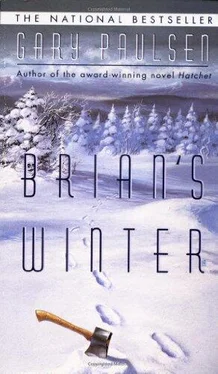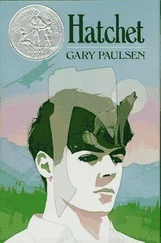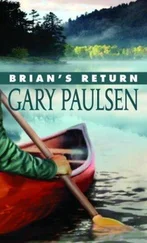He did all this with the hair side in and when he put the rabbit-skin shirt on underneath and then the moose-hide parka on the outside — even with the moose hide still uncured — he could feel his body warming up instantly.
He also nearly went down with the weight. He figured the coat weighed at least thirty pounds, maybe more, and decided he wouldn’t be doing much running in it.
The snowstorm lasted three days on top of the rain and Brian worked on his weak spot — his hands. He used moose hide and made a pair of crude mittens by using his hands for a pattern and a piece of charcoal to draw on the hide. The thumbs were so large he could almost stick his whole hand in the thumbhole. These he made with the hair side in and fashioned them large enough to allow a second set of rabbit-skin mitts to be worn inside. The mittens were so big they kept falling off his hands and he used moose hide to make a cord that went over his shoulders and held the mittens up if he relaxed his hands.
This was all hard work and kept him busy for days, but worse work was the hide. As it dried it started to harden and it turned into something very close to a board.
He worked it back and forth over a rounded piece of wood as he’d done with the lacing and this process, trying to soften the dried moose hide, took longer than sewing up the clothing. And in the end he had to settle for less than he wanted. He had the hide loose where it counted, in the armpits and elbows and the hood, but much of the rest of it was only half supple, stiff enough so that he felt as if he were wearing a coat of armor and still stiff though he worked on it for hours when at last the storm ended.
Brian expected to be snowed in but in fact it was only eight or nine inches deep. It had been a fine, driven snow and hadn’t accumulated to any depth but it was blasted into everything. Many of the trees had a full six inches sticking out to the side of the tree, where the snow had been driven by the wind.
It was still beautiful in the sunlight but had a different look from the last, fluffy snow, and it was cold, a deeper cold than before.
Brian couldn’t estimate temperature but he thought it must be near zero, but quiet — the wind had stopped completely — and his clothes kept him as warm as if he’d been in the shelter.
He started to brush the snow off the stacked moose meat and then thought better of it. The meat was frozen and protected under the snow and ice from the rain and safer there than in the open. He didn’t think the bear would come — it must be hibernating by now, and the same for Betty, whom he hadn’t seen since just after the bear attack — so the meat should be all right just beneath the snow.
He needed wood and he spent most of that day dragging in dead poplar, finally taking the parka off because it was so heavy and working in the rabbit-skin shirt alone. Everything had ice frozen on it but it chipped off easily with the hatchet. When he had a good stack — enough for another week (he was definitely gun-shy now about storms) — he chopped some meat off one of the back legs of the moose for stew and settled in for another night of rubbing the hide of his parka to soften it.
And he wondered that night — the night of day ninety-four — if this was it; was this all winter would be? Eating meat and rubbing hide and waiting for the next rain to turn to snow?
It did not rain again.
Nor did the snow go away. The temperature stayed down and in four days it snowed lightly, maybe an inch, and then in four more days another inch or two and then in four more days…
Regular as clockwork winter came. The snow never came deeply, never another wild blizzard, just an inch or two every four days. But the snow didn’t leave between times, didn’t melt, and before long there was a foot on the ground, a foot of dry powder.
At first it was all very settled and comfortable. Brian’s clothing seemed to work, he had plenty of meat and plenty of firewood — although he had to go some distance to get it. He knew how much wood it would take for a given time and brought in enough for a week — it took a full day — and then had nothing to do the rest of the week except work his moose-hide clothing against the wooden peg to soften it and eat moose-meat stew.
Summer had been so active and now he had suddenly come to a virtual stop. He couldn’t fish anymore because the ice was too thick to chop through with the hatchet, he didn’t need to hunt because he had — he figured roughly — four hundred pounds of moose left to eat. Lying by the fire one evening softening hide, he did some rough math, and if he ate four pounds of moose meat a day he would make at least a hundred days before needing more meat. More than three months. Let’s see, he thought, it was late November now, no, early December, no, wait…
He counted the days on his marks and decided it was the last week in November. Thanksgiving — he’d forgotten Thanksgiving.
He could do that. Have a Thanksgiving meal. The date was a little off, he would be late, but it felt good to think of it and he prepared for it as if he were home.
He would eat moose, of course, but he had found that the hump meat was the best and he chopped a three-pound piece off the frozen block by his door.
He would need more — some kind of sauce.
Then he remembered the berries. On one of his wood-gathering runs he’d gone past the north end of the lake and there had been a string of small, scraggly trees loaded with bright red berries. Because everything was under a foot of snow and he hadn’t seen a berry since summer these berries — looking fresh and bright even though they were frozen solid — struck him as very odd. They looked delicious and hung in small clumps and he smelled them, then took a handful and popped them into his mouth.
At first he couldn’t taste them because they were frozen but as soon as they thawed he got the flavor. They were tangy and had a mild bitter taste that made him want to pucker — also they had large pits. They were similar to the gut cherries he’d had trouble with during the summer except that they didn’t make him sick and the sour taste reminded him of something else he couldn’t at first place and later remembered as a vinegar or sour sauce flavor.
They would make a good sauce for a Thanksgiving meal and he went along the lakeshore and picked one of the smaller aluminum pans full and it was in this way that he learned about snowshoes.
It did not come that fast. There was about a foot of snow, powder but with a stiffness, and as he walked along the lake in his deer-hide boots he startled a rabbit from beneath an evergreen and it took off like a shot — all changed to white — across the snow.
Without sinking in. Brian watched it run away and had taken another four or five steps when it hit him that the rabbit was running on top of the snow while Brian was sinking in with each step.
He moved to the rabbit’s tracks and studied them. They were huge, fully twice the size of the feet he had seen on rabbits earlier, and when he examined the tracks more closely he saw that the rabbit had grown hair to increase the size of its feet and he thought how perfect they were: to be able to do that, change color in the winter and grow bigger feet to stay on top of the snow. How perfect. And he set the information back in his mind and went on about preparing for Thanksgiving.
He packed snow in with the berries and put them on the fire to melt and boil; then he put the hump meat in the large pan with snow and set that on to boil as well.
So much, he thought, for cooking Thanksgiving dinner.
What he wanted was a table and a chair and a tablecloth — no, he thought. What he wanted was a turkey and all the trimmings and then a table and chairs and tablecloth and his mother and father sitting with him and milk, oh yes, a glass of cold milk and bread and butter and potatoes and gravy and…
Читать дальше











